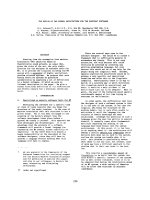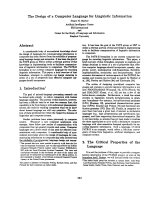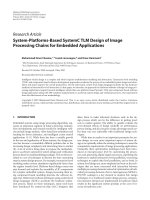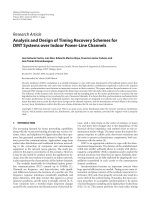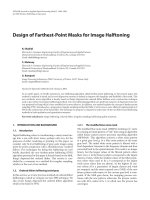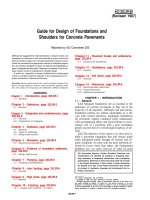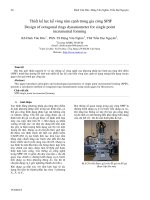Robust design of miniaturised spindle motors for hard disk drive
Bạn đang xem bản rút gọn của tài liệu. Xem và tải ngay bản đầy đủ của tài liệu tại đây (11.87 MB, 277 trang )
ROBUST DESIGN OF MINIATURISED SPINDLE
MOTORS FOR HARD DISK DRIVE
GAO XIAN KE
NATIONAL UNIVERSITY OF SINGAPORE
2002
ROBUST DESIGN OF MINIATURISED SPINDLE
MOTORS FOR HARD DISK DRIVE
GAO XIAN KE
(M.Eng, B.Eng)
A THESIS SUBMITTED
FOR THE DEGREE OF DOCTOR OF PHILOSOPHY
DEPARTMENT OF
ELECTRICAL AND COMPUTER ENGINEERING
NATIONAL UNIVERSITY OF SINGAPORE
2002
Acknowledgements
Acknowledgements
The road to this Ph.D. degree has been frustrating and fulfilling at all times.
There has been long up hill stretches as well as exhilarating downhill sprints. Without
the dear affection of people I have met along, it would not have been possible to reach
this destination.
First of all, I am greatly indebted to Professor Low Teck Seng, for giving me the
opportunity to complete my academic journey under his supervision. He has been a
constant source of encouragement and has provided valuable insight toward solving
the problems addressed in this work. I would like to express my genuine gratitude to
him for his excellent guidance and advice during the research work.
I also wish to express my sincere appreciation to Dr. Chen Shixin for his
guidance with high experienced perspective. Some parts of this work would not have
been possible without his guidance, encouragement and support. Unfortunately, he
passed away when I almost finished my thesis. I would like to dedicate this thesis to
the memory of Dr. Chen Shixin.
I am also deeply thankful to Dr. Liu Zhejie, Dr. Bi Chao and Dr. Guo Guoxiao
for their valuable time, support and recommendations. I would like to thank Prof. Loh
Han Tong and Prof. M. A. Jabbar for agreeing to serve as committee members. I am
very grateful to Dr. Zhang Qide, Dr. Yang Jiaping, Mr. Wang Hongtao, Mr. Li
Xinping and Mr. Shen Zhenqun, all members in MCAD & EDM groups, for their
ideas and help throughout the project. I would also like to thank Mr. Lim Thiam Soh
and Ms. Cynthia with their support and help.
Special note of appreciation to my friends’ kind and selfless support and help.
i
Acknowledgements
Words are inadequate to express my gratitude to my wife and family, for their
patience, selfless and immense support. True love and encouragement was provided by
my parents and parents-in-law which kept me through thick and thin. Especially, I
would like to dedicate this work to my lovely son, Wenqi, who always gives me
heartwarming encouragement throughout my research and study.
ii
Table of Contents
Table of Contents
Acknowledge i
Table of Contents iii
List of Tables viii
List of Figures xiii
List of Symbols xvi
Summary xxi
Chapter 1 Introduction
1.1 Introduction 2
1.2 Research Objectives 3
1.3 Literature Survey 4
1.3.1 Survey of Robust Design Methodology 4
1.3.2 Survey of the Grey System Method and the Monte
Carlo Method 12
1.4 Hard Disk Drive Technology 13
1.5 Scope of Work 17
1.6 Organization of Thesis 18
Chapter 2 Numerical Calculation of HDD Spindle Motor
2.1 Introduction 22
2.2 Original Design and Finite Element Analysis 23
iii
Table of Contents
2.2.1 Torque Calculation 25
2.2.2 UMP Calculation 28
2.2.3 Power Loss Calculation 30
2.3 Parameter Analysis 32
2.4 Conclusions 37
Chapter 3 Robust Design of Torque Optimization for HDD Spindle
Motors Using Taguchi Method
3.1 Introduction 39
3.2 Review of Taguchi Method 41
3.3 Taguchi’s System Design and Parameter Design for Torque
Optimization 47
3.3.1 Background 47
3.3.2 Objective Definition 49
3.3.3 Experimental Design 49
3.3.4 Prediction, Verification and Analysis 53
3.4 Conclusions 61
Chapter 4 Robust Parameter Design and Tolerance Design for UMP
Optimization
4.1 Introduction 64
4.2 Review of Taguchi’s Parameter and Tolerance Design 65
4.3 Objectives and Screening Experiment 68
4.4 Taguchi’s Parameter Design for UMP Optimization 72
4.5 Taguchi’s Tolerance Design for UMP Optimization 76
iv
Table of Contents
4.6 Conclusions 78
Chapter 5 Robust Torque Optimization of HDD Spindle Motors
Using Response Surface Methodology
5.1 Introduction 81
5.2 Response Surface Methodology 82
5.2.1 Analysis Techniques 84
5.2.2 Conceptualization of the Central Composite Design 87
5.3 Torque Optimization Using Mixed Resolution Central
Composite Design 90
5.3.1 Mixed Resolution Central Composite Design 91
5.3.2 Torque Optimization 94
5.3.3 Zoom-In MR-CCD Design 98
5.4 Torque Optimization Using Higher Degree Model Technique 102
5.5 Conclusions 105
Chapter 6 Hybrid Robust Design of Torque Optimization for HDD
Spindle Motors
6.1 Introduction 108
6.2 Proposed Methodology 111
6.2.1 Step One: Identifying Variables 113
6.2.2 Step Two: Determining Order 114
6.2.3 Step Three: Constructing Experiment 114
6.2.4 Step Four: Fitting Model 114
6.2.5 Step Five: Optimizing Variables 115
v
Table of Contents
6.2.6 Step Six: Analyzing Performance 116
6.3 Hybrid Design for Torque Optimization 116
6.3.1 Spindle Motor Torque Optimization 117
6.3.2 Zoom-In Hybrid Design 121
6.4 Conclusions 123
Chapter 7 Robust Design Using Grey Relational Analysis Based on
Orthogonal Array
7.1 Introduction 126
7.2 Grey Relational Analysis 127
7.3 Torque Optimization Using Grey Relational Analysis 131
7.3.1 Grey Relational Analysis Based on Orthogonal
Array Experiment 131
7.3.2 Grey Relational Analysis Based on Reduced OA
Experiment 136
7.4 Improved Grey Relational Analysis 140
7.4.1 Original Grey Relational Analysis 140
7.4.2 New Grey Relational Analysis 142
7.4.3 Analysis and Assessment 145
7.4.4 Concluding Remarks 147
7.5 Conclusions 148
Chapter 8 Robust Design Incorporated with Monte Carlo Method
8.1 Introduction 150
8.2 Review of Monte Carlo Method 151
vi
Table of Contents
8.3 Torque Optimization Using RSM with Monte Carlo Simulation 155
8.3.1 Proposed Approach Using TEE and MCS 156
8.3.2 Torque Optimization Using MCS 159
8.4 Results and Discussion 164
8.5 Conclusions 165
Chapter 9 Conclusions and Future Research
9.1 Summary of Research Results 168
9.2 Summary of Conclusions 170
9.3 Original Contributions 173
9.4 Future Work 175
References 178
Publications 199
Appendix A 203
Appendix B 233
vii
List of Tables
List of Tables
Page
Table 1.1 Comparison of Taguchi Method and RSM 7
Table 2.1 Iron Loss Calculation 32
Table 2.2 Levels of Design Parameters 33
Table 2.3 Experiments Using FEA 34
Table 3.1 Design Parameters 52
Table 3.2 Effect of Various Factors on the Performance Indices 56
Table 3.3 Prediction and Verification for Robust Design Using Taguchi
Method 57
Table 3.4 Verification Using Original Design With Noise Effect 59
Table 3.5 Verification Using Traditional Optimization With Noise Effect 59
Table 3.6 Verification Using Taguchi’s Parameter Design
With Noise Effect 59
Table 4.1 Confounding Effects Caused by a Wrong Layout 70
Table 4.2 Experiments Using Screening Method 71
Table 4.3 Analysis of Variance for S/N Ratio 74
Table 4.4 Comparison between Original Design and Taguchi’s
Parameter Design 74
Table 4.5 Analysis of Variance for Standard Deviation 77
Table 4.6 Performance Comparison Using Parameter Design and
Tolerance Design 78
Table 5.1 The Analysis of Variance 85
Table 5.2 Different α Values for the Rotatable CCD 88
Table 5.3 Standard CCD with Three Variables 88
viii
List of Tables
Table 5.4 Modified CCD for Two Variables and One Noise Variable 89
Table 5.5 Design Parameters (Control & Noise Factors) 95
Table 5.6 Analysis of Variance 97
Table 5.7 New Regions for Design Parameters 99
Table 5.8 Analysis of Variance (Zoom-in) 100
Table 5.9 Comparison of Original Design and MR-CCD Design 101
Table 5.10 Analysis of Variance 102
Table 5.11 Analysis of Variance 103
Table 5.12 New Regions for Design Parameters (II) 104
Table 5.13 Analysis of Variance 104
Table 6.1 Control and Noise Variables 118
Table 6.2 Coded and Natural Values of Control Variables 118
Table 6.3 Coded and Natural Values of Noise Variables 119
Table 6.4 The Analysis of Variance Table of Mean Cogging Torque T
µ
121
Table 6.5 The Analysis of Variance Table of Standard Deviation for
Cogging Torque T
σ
121
Table 6.6 The Analysis of Variance Table of Mean Cogging Torque T
µ
(Zoom-in) 122
Table 6.7 The Analysis of Variance Table of Standard Deviation for
Cogging Torque T
σ
(Zoom-in) 122
Table 6.8 Predicted and Verified Results for Optimum Control Variables
and Performances 123
Table 7.1 Original Data Series 130
Table 7.2 Pre-processed Experimental Data 132
Table 7.3 Grey Relational Coefficient 133
Table 7.4 Grey Relational Grades and S/N Ratios 133
Table 7.5 ANOM for S/N Ratio and Grey Relational Grade 133
ix
List of Tables
Table 7.6 Comparison of Optimum Results Using GRA and Taguchi
Method 135
Table 7.7 ANOVA for Grey Relational Grade 135
Table 7.8 ANOVA for S/N Ratio 135
Table 7.9 Pre-processed Experimental Data for Reduced Experiment 136
Table 7.10 Grey Relational Coefficient for Reduced Experiment 137
Table 7.11 Grey Relational Grades and S/N Ratios for Reduced
Experiments 137
Table 7.12 ANOM for SNR and GRG for the Reduced Experiment 138
Table 7.13 ANOM for GRG for the Reduced Experiment (II) 139
Table 7.14 Grey Relational Coefficient Using Improved GRA 145
Table 7.15 Grey Relational Grades Using Improved GRA 146
Table 7.16 ANOM for New Grey Relational Grade 146
Table 7.17 ANOVA for Grey Relational Grades Using Improved GRA 147
Table 8.1 Design Variables (Control & Noise Factors) 159
Table 8.2 ANOVA after Monte Carlo Simulation 161
Table 8.3 Comparison of RSM Design and RSM+MC Design 162
Table A-1 L9 (3
4
) Orthogonal Array 203
Table A-2 Common Orthogonal Arrays with Number of Equivalent Full
Factorial Experiments 203
Table A-3 Cogging Torque for a 6-pole 9-slot Spindle Motor Using
Taguchi’s Parameter Design 204
Table A-4 Running Torque for a 6-pole 9-slot Spindle Motor Using
Taguchi’s Parameter Design 205
Table A-5 Experiment for a 6-pole 9-slot Spindle Motor Using
Conventional Optimization Method 206
Table A-6 Experiment of Noise Effect for a 6-pole 9-slot Spindle Motor
After Using Traditional Optimization 207
x
List of Tables
Table A-7 Experiment of Noise Effect for a 6-pole 9-slot Spindle Motor
After Taguchi’s Parameter Design 207
Table A-8 Screening Experiment for UMP Optimization of an 8p9s
Spindle Motor 208
Table A-9 ANOM in Screening Experiment for an 8p9s Spindle Motor
– UMP Analysis 209
Table A-10 ANOVA in Screening Experiment for an 8p9s Spindle Motor
– UMP Analysis 210
Table A-11 Inner Array (L9) for an 8p9s Spindle Motor
– UMP Analysis 211
Table A-12 Outer Array (L9) for an 8p9s Spindle Motor
– UMP Analysis 212
Table A-13 Performances in Crossed Experiment Using Taguchi’s Parameter
Design for an 8p9s Spindle Motor – UMP Analysis 213
Table A-14 ANOM in Parameter Design for an 8-pole 9-slot Spindle Motor
– UMP Analysis 214
Table A-15 ANOVA in Parameter Design for an 8-pole 9-slot Spindle Motor
– UMP Analysis 214
Table A-16 Tolerance Design I: Experiment for an 8-pole 9-slot
Spindle Motor – UMP Analysis 215
Table A-17 Tolerance Design II: Experiment for an 8-pole 9-slot
Spindle Motor – UMP Analysis 216
Table A-18 Current Distribution for an 8-pole 9-slot Spindle Motor
– UMP Analysis 217
Table A-19 Mixed Resolution CCD Experiments for a 6-pole 9-slot
Spindle Motor 218
Table A-20 Zoom-in Mixed Resolution CCD Experiments for a 6-pole
9-slot Spindle Motor 219
Table A-21 Cogging Torque Simulation and Analysis for a 6-pole 9-slot
Spindle Motor Using Crossed Experiment Design 220
Table A-22 Running Torque Simulation and Analysis for a 6-pole 9-slot
Spindle Motor Using Crossed Experiment Design 221
Table A-23 The Ratio of Tc/Tr Simulation and Analysis for a 6-pole 9-slot
Spindle Motor Using Crossed Experiment Design 222
xi
List of Tables
Table A-24 Cogging Torque Simulation and Analysis for a 6-pole 9-slot
Spindle Motor Using Pareto-Optimal Design 223
Table A-25 Running Torque Simulation and Analysis for a 6-pole 9-slot
Spindle Motor Using Pareto-Optimal Design 223
Table A-26 The Ratio of Tc/Tr Simulation and Analysis for a 6-pole 9-slot
Spindle Motor Using Pareto-Optimal Design 224
Table A-27 Experiment of Noise Effect for a 6-pole 9-slot Spindle Motor (Tc)
225
Table A-28 Experiment of Noise Effect for a 6-pole 9-slot Spindle Motor (Tr)
225
Table A-29 Experiment of Noise Effect for a 6-pole 9-slot Spindle Motor
(Tc/Tr) 226
Table A-30 Crossed Experiment for an 8-pole 6-slot Spindle Motor 227
Table A-31 Crossed Experiment for an 8-pole 6-slot Spindle Motor
(Zoom-in) 228
Table A-32 Cogging Torque for a 6-pole 9-slot Spindle Motor
Using Reduced Experiment Design 229
Table A-33 Cogging Torque for a 6-pole 9-slot Spindle Motor
Using Reduced Experiment Design (II) 230
Table A-34 Pre-processed Experimental Data for Reduced Experiment (II)
230
Table A-35 Grey Relational Coefficients for Reduced Experiment (II) 231
Table A-36 Grey Relational Grades and S/N Ratios for Reduced
Experiments (II) 231
Table A-37 Noise Effect on Cogging Torque for a 6-pole 9-slot Spindle
Motor Using Grey Optimal Design 232
xii
List of Figures
List of Figures
Page
Figure 1.1 Conceptual framework of experimental design 5
Figure 1.2 Overview of hard disk drive 14
Figure 2.1 Geometry modeling of an 8-pole 9-slot BLDC spindle motor 24
Figure 2.2 Cross section of one slot and half pole of HDD spindle motor 24
Figure 2.3 Mesh and field distribution of 8-pole 9-slot BLDC spindle motor 25
Figure 2.4 Cogging and running torque profile 27
Figure 2.5 The computed cogging torque profile of 8-pole/12-slot spindle
motor 28
Figure 2.6 The measured cogging torque profile of 8-pole/12-slot spindle
motor 28
Figure 2.7 The UMP produced in 8-pole 9-slot spindle motor 29
Figure 2.8 Total iron loss distribution 31
Figure 2.9 Eddy current loss distribution 31
Figure 2.10 Hysteresis loss distribution 31
Figure 2.11 Torque performance versus tooth face angle (x
1
) and
Tooth face ‘II’ radius (x
3
) 36
Figure 3.1 Flow of design optimization using Taguchi method 48
Figure 3.2 Structure of a 6-pole 9-slot spindle motor 50
Figure 3.3 Field distribution using FEA 50
Figure 3.4 Parameters of one-pole and half slot part for spindle motor 51
Figure 3.5 Cogging and running torque profiles in original design 54
Figure 3.6 Cogging and running torque profiles in conventional optimization
(without consideration of noises) 54
xiii
List of Figures
Figure 3.7 Cogging and running torque profiles in Taguchi robust design
(with consideration of noises) 54
Figure 3.8 The average SNRs (T
c
) in different settings of control factors 55
Figure 3.9 The average SNRs (T
r
) in different settings of control factors 55
Figure 3.10 Noise factor ∆P’s effect on torque performance in conventional
optimization design and Taguchi design 58
Figure 3.11 Noise factor ∆La’s effect on torque performance in conventional
optimization design and Taguchi design 58
Figure 3.12 Noise factor ∆Rp’s effect on torque performance in conventional
optimization design and Taguchi design 58
Figure 4.1 Effect on UMP using screening experiment 71
Figure 4.2 S/N Ratios and means of UMP using ANOM 73
Figure 4.3 Contributions of parameters to performance (S/N) 74
Figure 4.4 Contributions of parameters to variation of performance 77
Figure 5.1 CCD for 2 variables and 3 variables 87
Figure 5.2 Window moving and zoom-in 98
Figure 7.1 GRGs at each level for different factors 134
Figure 7.2 SNRs at each level for different factors 134
Figure 7.3 GRGs at each level for different factors in reduced
experimental design 138
Figure 7.4 GRGs at each level for different factors in reduced
experimental design (II) 139
Figure 7.5 The relationship between different identifying factors (ζ) and
the grey relational coefficient in the original method 141
Figure 7.6 The relationship between different identifying factors (ζ) and
the grey relational coefficient in the improved method 141
Figure 7.7 The relationship between different identifying factors (ζ) and
the grey relational coefficient in the new method (λ=3) 143
Figure 7.8 The relationship between different identifying factors (ζ) and
the grey relational coefficient in the new method (λ=2) 143
xiv
List of Figures
Figure 7.9 New GRGs at each level for different factors 147
Figure 8.1 The logic flow of a Monte Carlo simulation 158
Figure 8.2 The torque values of RSM model and MC model under noise
effect 163
Figure B-1 Predicted response surfaces of T
c
/T
r
vs. different parameters
combination 235
Figure B-2 Predicted response surfaces of UMP vs. different parameters
combination 238
Figure B-3 Predicted response surfaces of the fitted response model for the
the 6-pole 9-slot spindle motor 241
Figure B-4 Predicted contours of the fitted response model for the
6-pole 9-slot spindle motor 244
Figure B-5 Predicted response surfaces of the fitted response model for
the 6-pole 9-slot spindle motor (zoom-in) 247
Figure B-6 Predicted contours of the fitted response model for
the 6-pole 9-slot spindle motor (zoom-in) 247
Figure B-7 Second-degree fitted response surfaces (crossed-experiment) 248
Figure B-8 Third-degree fitted response surfaces (crossed-experiment) 249
Figure B-9 Second-degree fitted response surfaces using pareto-optimal
design 250
Figure B-10 Visualization of the fitted response model for the 8-pole 6-slot
spindle motor 251
Figure B-11 Visualization of the fitted response model for the 8-pole 6-slot
spindle motor (zoom-in) 252
xv
List of Symbols
List of Symbols
A = tooth face angle
A
i
= the area of irregular shape
A
s
= the area of square
B
n
= the normal flux density
B
t
= the tangential flux density
b = vector (k
×
1) of the estimated regression coefficients
b
i
= regression coefficients related to control factors
C = tooth face ‘I’ angle
C
ii
= the diagonal element of (X
T
X)
-1
corresponding to b
i
E() = the expectation
F(x) = the distribution function
f(x) = the distribution density function
H
0
= the null hypothesis
H
m
= the thickness of magnet
H
m
×
H
y
= Interaction between H
m
and H
y
H
y
= the thickness of yoke
L
a
= air gap length
l = the edge length of square
m = the overall mean of performance statistics
i
x
m
= the mean of performance statistics of x control factor at i level
xvi
List of Symbols
n = number of experiment runs
n
0
= the equivalent sample size
n
r
= the number of repetition of the verification
P = pole-arc/pole-pitch ratio
Q() = quality loss
R = an appropriate experimental region
R
2
= a measure of the proportion of total variation of the y
l
s about the
mean
y explained by the fitted regression model
R
A
2
= the adjusted R
2
statistic
R
p
= tooth face ‘II’ radius
R
set
2
, R
A,set
2
= presetting values of R
2
and R
A
2
r
i
= regression coefficients related to noise factors
s
2
= standard deviation
S
i
= scale factor
S/N = signal-to-noise ratio
SSE = the sum of squares not accounted for by the fitted model
SSR = the sum of squares due to regression of the fitted model
SSSF
x
= the sum of squares due to each factor
SST = total sum of squares
t
i
= tolerance of i
th
variable
T
c
= cogging torque
T
r
= running torque
T
c
/T
r
= ratio of cogging torque to running torque
µ
T
= mean torque performance
σ
T = variance of torque performance
xvii
List of Symbols
X = matrix (n
×
k) of the levels of the independent variables
i
X = the mean of the X
ij
values (i is the number of the control
variables, j is the level number)
X
i
*
= the new boundary values for each variable
X
i0
*
= the central values in the new ranges
X
i,high
, X
i,low
= the original boundary values for each variable
x
1
, …, x
n
= the variables of a product
4321
ˆ
,
ˆ
,
ˆ
,
ˆ
xxxx = stationary point from fitted second-order model
x
0
(1), …, x
0
(n) = reference series
x
i0
= original value of i
th
variable
()
kx
i
*
, = the value after and before the data preprocessing
()
()
kx
i
0
x
A
= weight coefficient of control factor A
x
H
= weight coefficient of control factor H
y
x
li
= the value (or level) of the i
th
controllable factor in the l
th
trial
x
L
= weight coefficient of control factor L
a
x
P
= weight coefficient of control factor P
Y = vector of the performance observations
y = the actual performance characteristic
y = the mean of the performance
y
~
= the performance characteristic of fitted model
y
l
= the observed response value in the l
th
trial
y
m
= the fitted primary response value
y
s
= the fitted secondary response value
y
uv
= the v
th
response at the u
th
design point
z = a sets of noise factors
∆
P = processing deviation of pole-arc/pole-pitch ratio
xviii
List of Symbols
∆
L
a
= processing and machining deviation of air gap length
∆
R
p
= machining deviation of tooth face ‘II’ radius
()
k
i0
∆ = the absolute value of difference between and
()
kx
i
*
()
kx
*
0
∆
max
= the maximum value of
(
)
k
i0
∆
∆
min
= the minimum value of
(
)
k
i0
∆
Φ
(x) = the distribution function of the standardized normal distribution
with mean 0 and variance 1
Φ
new
= the value of the parameter
Γ
(x
0
, x
i
) = grey relational grade between the compared series x
i
and
referential series x
0
α
= rotatable factor for CCD
β
= vector (k
×
1) of the regression coefficients
β
0
,
β
i
= the unknown parameters to be estimated of RSM model
β
k
= the weight of
(
)
(
)
(
)
kxkx
i
,
0
γ
δ
= the desirable or acceptable value of the secondary response
ε
= vector (n
×
1) of random errors
ε
i
= the error made when observing y
i
γ
0i
(k) = grey relational coefficient between the k
th
elements of the
compared series x
i
(k) and the referential series x
0
(k)
λ
= the amending coefficient
µ
= mean value of the distribution
µ
0
= user’s specified target mean value
µ
y
= the mean of performance y
ρ
i
= the coefficients for the new reduced ranges for each variable
σ
0
= user’s specified target maximum acceptable variance
xix
List of Symbols
σ
e
= the error variance
σ
i
= standard deviation of the distribution
σ
pred
= the variance of the prediction error
σ
y
= variance of performance y
ζ = identifying factor
xx
Summary
Summary
Designing high quality products and processing and manufacturing at a low cost
is ever technologically and economically challenging us. Robust Design
Methodologies provides a systematic way to meet the challenge in improving the
quality and reducing the cost. Robust design is a set of experimental optimization
techniques to achieve a designer’s specified target mean response and simultaneously,
minimizing its variance. It uses experimentation of products and processes to
determine the best settings of controllable parameters (control factors) that make the
products and processes robust to uncontrollable parameters (noise factors). The
combination of engineering concepts and statistical implementations in robust design
has proved to be invaluable.
In this dissertation, we considered the problems in designing experiments and
optimization analysis in the robust design for electromechanical components in hard
disk drive, tailored for spindle motors in this research. This is a significant issue since
the choice of the design parameter values could affect all aspects of the
product/process specification. This is the leading work in systematical research and
application of robust design in hard disk drive industry.
As the objective of the research is to formulate effective robust design
approaches systematically for the design and optimization of miniaturized
electromagnetic devices in hard disk drive, two important and effective methods in
robust design methodologies, namely Taguchi method and Response Surface
Methodology (RSM), are studied thoroughly in this dissertation. The approaches using
Taguchi method and RSM are proposed in the torque and UMP optimization for HDD
xxi
Summary
spindle motors. To reduce the number of experimental configurations, orthogonal array
(OA) and central composite design (CCD) schemes are used to select an intelligent
subset of the parameter space. “Analysis of Mean” (ANOM) and “Analysis of
Variance” (ANOVA) are carried out to estimate quantitatively the effects of design
parameters on concerned performances. The study indicates the applicability and
effectiveness of Taguchi’s robust design approach and RSM for optimization in HDD
spindle motors design.
Several effective alternatives are proposed in this research to deal with the
weaknesses of Taguchi’s design and RSM approach in torque optimization for HDD
spindle motors. The hybrid design, which is an integration of regression model and
orthogonal array approach, is proposed for multiple-response optimization. The study
searches the possible near-optimal point using dual response models for mean and
variance of torque performance. The approach provides a rational platform for the
systematic identification of robust design in a multiple objective domain.
To solve the problems of insufficient data in engineering process, The Grey
System method is proposed. This efficient system engineering technique which is the
easiest correlation-induction approach, is employed in the robust design of HDD
spindle motors. The optimization results generated using grey relational analysis
(GRA) agree with that of Taguchi’s robust design, with same or even less experiments
runs than orthogonal array. It is very helpful when ever some experiments could not be
realized or the experimental result is wrong or hard-to-get. It is applied, for the first
time, in the robust design of HDDs.
The existing RSM is further modified to improve its performance by
incorporating the Monte Carlo (MC) method and trimmed element estimation (TEE)
technique. The Monte Carlo method allows real-world industrial problems to be
xxii
Summary
analyzed without the need to make unrealistic simplified assumptions when using
deterministic mathematical models. The new RSM model is built using the new design
approach proposed. The new RSM model can generate better performance compared
to that in direct RSM, without much increases in computing time and FEA
experiments. The accuracy of the RSM is thus improved.
In summary, we have shown that a few robust design technologies, namely: 1)
Taguchi method, 2) Response Surface Methodology, 3) Grey System method and, 4)
Monte Carlo method, are effective and efficient tools to realize the robust optimization
for HDD spindle motors. A design of product with these techniques will achieve low
cost or low variation but high performance.
xxiii

